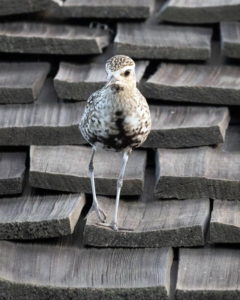
Roger’s returned kōlea, Wally. Or is it? © Roger Kobayashi’s photo, August 14, 2022
August 21, 2022
We kōlea fans are all pointing, smiling, and sometimes even getting misty-eyed over the sight of our plovers returning from Alaska. We’re so moved because, thanks to Dr. Wally Johnson’s decades of research, we know that the little bird that recently appeared in our yard, park, or roadside has just flown 3,000 miles nonstop over the Pacific Ocean, through the jet stream, tradewinds, and storms to make the journey in 3-to-4 days.
Other shorebirds also accomplish such amazing feats of flight, but Hawaii’s plovers are also special in being what researchers call site faithful, meaning that if they survived a winter in a particular place, they return to it year after year. The stakes in this are high. As Wally once explained to me, for a kōlea, finding and keeping a successful foraging patch may be a matter of life or death, a situation well worth a fight if other birds dare to trespass.
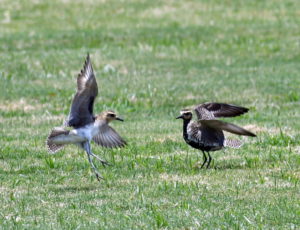
Two kōlea squabbling over a patch in Punchbowl Cemetery. © Susan Scott
Not all of the world’s shorebirds have been studied like our kōlea, but as far as is known, only Hawaii’s plovers are this loyal to a specific location during the winter season. This is also true, especially for male plovers, on their summer breeding grounds in Alaska. Such fidelity to a site is what allows us to accurately count kōlea since the same bird is always foraging in the same spot. When a startled kōlea flies from its patch, an area ranging in size from a tenth of an acre to a football field, the same kōlea soon returns to that spot.
Commitment-to-location also suggests that the bird we see year after year in our backyard, or on a street corner, is the same individual. There’s the possibility, however, that the former bird died, and a new one has found the site, but we often know “our” bird by its personality traits.
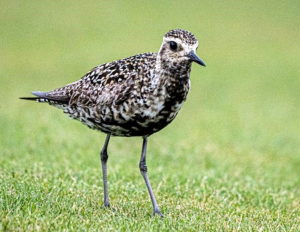
It’s nearly impossible to tell one bird from another, or a male from female, by its August feather colors. The birds begin shedding their spring breeding colors while still in Alaska and new winter-color feathers grow in day by day after they arrive in Hawaii. This bird (August 11th photo) in plover-fan Roger Kobayashi’s yard may be the same bird as the one in Roger’s top photo of August 14. Or not. Without legs bands, it’s impossible to be sure who’s who. © Roger Kobayashi
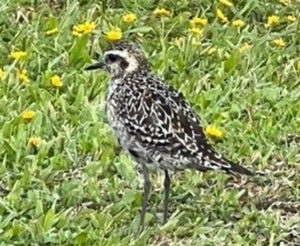
Kolea fans Jo Rowley and Brian Hill sent this photo, wondering if this bird, spotted August 5, 2022, spent the summer here because it’s so plump. We would only know that if the bird was seen in Hawaii in June, after the northern migration time in April-May, but before early returns in July.
Of course, no one can be 100 percent sure which bird is which without some kind of identification marker, such as the plastic and metal leg bands, tiny lightweight bracelets, researchers use for this purpose. Colored bands are how we identified Mr. X, an adult kōlea Wally banded in the X section of Punchbowl Cemetery in April, 2004.
Mr. X was spotted in his X patch last week on August 16, a cause for celebration among plover watchers. About Mr. X’s return, Wally emailed, “Mr. X is a minimum 20 years, 1.5 months old. We can ID juvenile Kōlea (10 months old in spring), but the age of adults is always unknown, so we have to assume an age of at least 1 year 10 months when we band adults usually in April. So . . . if Mr. X survives one more migratory cycle, he’ll likely wind up setting a new record.”
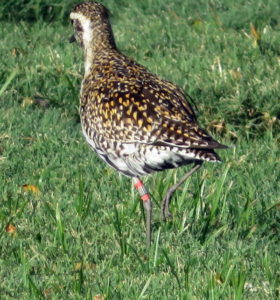
Mr. X on March 26, 2021. Read this band as RED-METAL-RED, left leg.© Sigrid Southworth
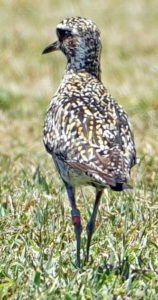
Mr. X on August 16, 2022. The bird’s upper red plastic band was lost but the metal and other red plastic band remain intact after 20-some years. © Susanne Spiessberger
Holding the current longevity record is another male, a plover Wally banded that returned for years to the same place at Bellow Air Force Station. The bird lived to the ripe old age of at least 21 years, 3 months.
It would be wonderful if all our kōlea wore ID bracelets, but even those birds that have learned to approach us for meal worms or scrambled egg treats (please feed your bird only these healthy foods) are difficult to catch for banding. Safely capturing a kōlea with two good wings is a feat for permitted professionals only, and it’s never easy. Just ask Wally.
But that doesn’t stop him, this energizer bunny of plover research. Wally and his associates are currently in the middle of learning more about the round-trip migrations of Pacific Golden-Plovers between Alaska and Hawaii. Details of his most recent tagging events are here, posted March 30th in the news tab of our Kōlea Count website.
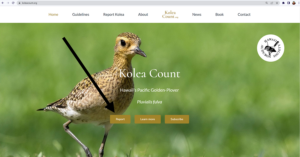
The Kolea Count season begins December 1st, which gives this summer’s chicks a chance to get to Hawaii and establish a territory. Until then, you can help collect kōlea data by entering the date you first noticed a kōlea return. See the website for details.
Mainland-based Johnson will be migrating back to Hawaii in October. Stay tuned for details about his visit and about a kōlea talk in November regarding the latest in plover research.
Hawaii is one of the few places in the world where humans and a migrant shorebird live together so harmoniously. The birds adapt to our presence, our lawns, and our introduced bugs, while we enjoy the grace, beauty, and stamina of one of Hawaii’s most remarkable native birds.
Thank you, tiny dancers, and welcome home.
A postscript:
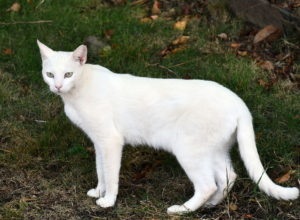
This is one of the free-roaming cats in Punchbowl Cemetery, the 9-month home of 70-to-80 Pacific Golden-Plovers. The notched ear indicates the cat has been neutered, and it looks well-nourished. © Susan Scott

Leashing pet cats keeps cats, as well as birds, safe. There are currently signs up on my street for 3 separate missing pet cats. Pictured above is my neighbor’s cat, Gabby, who welcomes the harness and leash because it means an outdoor excursion. ©Ruth Carlson